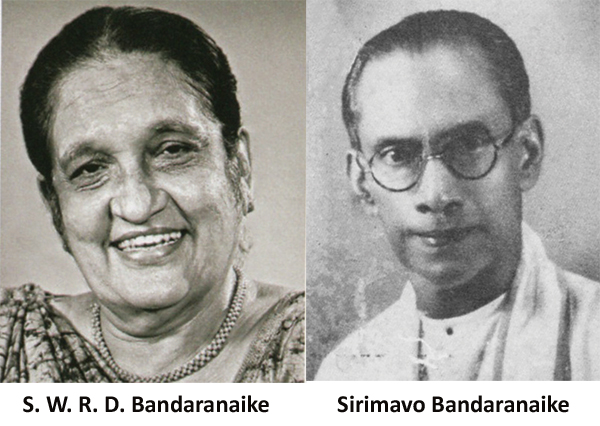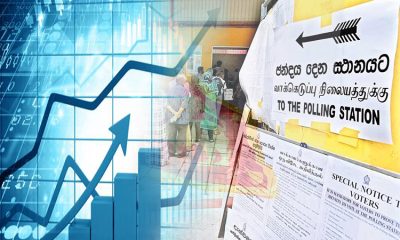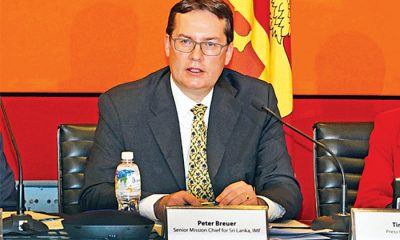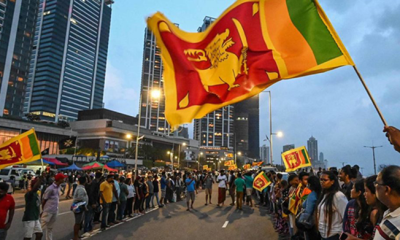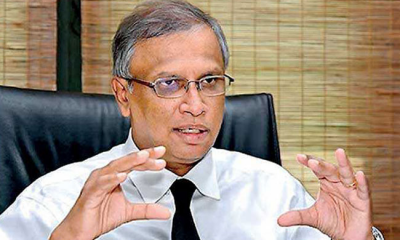Features
New political direction and its impact on Economy
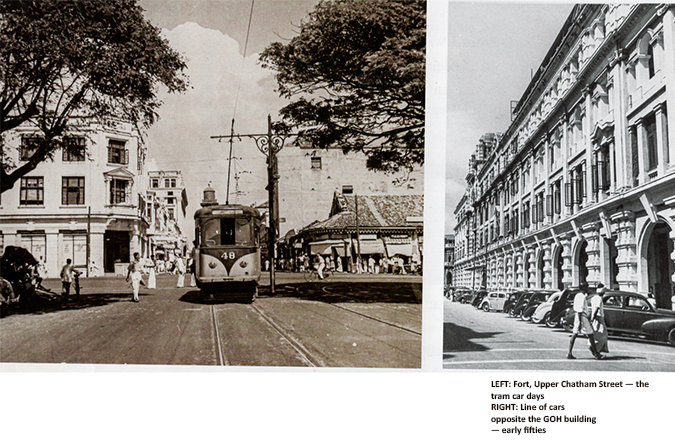
(Excerpted from the Merril J. Fernando autobiography)
No memoir straddling the period of the 1950s would be complete without a reference to the changes in our society, arising from the overthrow of the United National Party (UNP) Government in 1956, in power for two consecutive terms since Independence. The political, social, and cultural changes set in motion by the election victory of the coalition forces led by S. W. R. D. Bandaranaike, comprising the Mahajana Eksath Peramuna (MEP), permanently re-configured the political and the socio-economic landscape of the country.
That victory also ended the single party dominance which the UNP had enjoyed, for eight years of parliamentary rule since Independence, paving the way for the many subsequent instances of a major party assuming power, in combination with one or more smaller parties. The implementation of S. W. R. D. Bandaranaike’s pre-election assurances of language reforms and the nationalisation of large private enterprises, the latter comprising largely of British vested interests, soon brought about a new political and economic order, based on left-of-centre dogma conflated with strong anti-imperialist sentiment.
It resulted in the nationalisation of many successful businesses such as banks, insurance companies, and public transport. I recall that the many strikes that took place during this period, never before experienced in the country, had a crippling impact on imports and exports. The port workers strike of 1959 hit all industrialists equally.
Old-timers in the industry will no doubt recall the part played in easing tea exports by the Trincomalee Tea Administration (TTA), established in 1957/’58, specifically as a counter to the disruptions to tea exports by frequent work stoppages at the Colombo Port. I think that period also marked the beginning of State capitulation to trade union pressure, for increases in wages and salaries as well as the enrichment of other conditions, without corresponding returns through improvements in output.
The SWRD regime, meek in the face of worker agitation, very unwisely established the precedent for the State subsidization of unproductivity, emulated as and when dictated by political expediency by every government which followed. Unlike the MEP regime of SWRD, the preceding UNP governments, whilst consolidating post-independence parliamentary democracy, also exerted stronger control over both the economy and the administration, as well as on civil society.
However, despite the administrative and fiscal stability that the UNP governments ushered in after Independence, there was a strong groundswell of nationalist sentiment against the second UNP regime under Sir John Kotelawala, and that momentum was reflected in the comprehensive defeat of the UNP in 1956. My clear recollection is that whilst the ‘Five Great Forces’ – Sangha, Veda, Guru, Govi, and Kamkaru – arraigned behind SWRD, were expected to offer a serious challenge to the ruling party, very few would have envisaged the complete rout of the UNP that was the election result.
Whilst the foreign policy of the MEP regime was ostensibly neutralist, there was a visible leaning to the left, with the establishment of the first formal diplomatic relations with both the USSR and China, soon after SWRD assumed the premiership. The contrast with the foreign policies of the previous UNP governments was sharply outlined, on account of the latter’s clear alignment with British interests in the South East Asian region in particular. Unarguably, the opening of government to government relations with the Soviet Union and China, eventually resulted in long-term benefits, especially for the tea trade in the case of Russia.
In fairness to SWRD, it may be said that he turned the country away from heavy dependence on Western or pro-Western power blocs and steered it along a more non-aligned direction, expressed more clearly in the foreign policy implementation of the later regime of his widow, Sirimavo Bandaranaike.
SWRD and the plantation economy
With regard to the plantation sector, which reflected British dominance more aggressively than any other segment of industry, there had been vigorous left wing agitation for some time for its nationalization. However, during his relatively short period in office, there was no indication that SWRD was prepared to immediately enforce such a move although, on account of the political thinking of the SWRD regime, influenced by its Marxist coalition partners, that apprehension was ever present.
For the time being though, the plantations and allied commercial interests, which were then the largest foreign exchange earners for the country, remained mainly in the hands of the British and a few local entrepreneurs. However, the increase on tax on business profit from 25% to 30% and the enhanced export duties placed additional burdens on an industrial sector already under severe internal pressure on account of intermittent strikes and other interruptions to production. In my view, the most glaring weaknesses of the SWRD administration were its tolerance of industrial indiscipline and the management of the economy.
Notwithstanding his clearly opportunistic conciliation of nationalist sentiment, which propelled him to victory, S. W. R. D. Bandaranaike was still pragmatic enough to realize that a sudden disruption of the plantation economy and the closely-interconnected ancillary interests, then the primary source of Ceylon’s foreign exchange earnings, would have completely destabilized the country’s economy.
However, at the Planters’ Association AGM of 1957 chaired by Senator Thomas Amarasuriya (the first Ceylonese to be elected Chairman of the PA), to which Prime Minister Bandaranaike was an invitee, the latter had, in his speech, indicated clearly to the plantation representatives that nationalization of plantations was a key component of his Government’s strategy, though that would be the last measure in the Government’s nationalization programme.
Having said that, SWRD had also given the assurance that adequate notice would be given to the interests likely to be affected. The establishment, in 1958, of the State Plantations Corporation, was also an early warning of the thinking of the regime that plantation ownership and management would no longer be a private, colonial preserve.
In the meantime, the restrictions imposed on expatriates working in the country forced many of them to leave. Among them were experienced planters and tea tasters, many of whom relocated to African tea-growing countries, both in the South and the East of that continent, and helped to develop the industry in those locations with expertise acquired in Ceylon. Others took up employment in the plantation industry in South East Asian countries. Those countries which benefited from the tea experience of our country are our strongest competitors today.
Quite apart from all the above factors, the fear of nationalization itself had a negative impact on the development of plantations, especially those owned by British companies. The older generation of plantation managers and others associated closely with the industry will recall that those estates, owned mostly by ‘Sterling Companies’ as they were known, comprised the cream of our plantations.
Land reforms and conseqences
The biggest impact of the new political direction was finally felt when it paved the way for the Land Reform Policy enactment of 1972, implemented during the tenure of SWRD’s widow, Sirimavo Bandaranaike, as Prime Minister. In its initial stage it vested over half a million acres, about two-thirds of that extent in tea, rubber, and coconut, with the Land Reform Commission (LRC).
Whilst some of the land thus acquired belonged to British plantation companies, the major proportion was locally owned. Although one of the stated objectives of this exercise was the redistribution of land amongst the landless, only a fraction of the acquired land eventually found its way in to the hands of the Sinhala peasantry.
The actual physical transfer of ownership took place in 1975/’76, with acquired plantation land being divided between the Sri Lanka State Plantations Corporation (SLSPC) and the Janatha Estates Development Board (JEDB). The newly-formed Up-Country Cooperative Estates Development Board (Usawasama) also received land for management and re-distribution. So did various village cooperative societies and councils.
Though the latter two categories had minimal competence in large-scale plantation cultivation and land and crop management, the leading politicians of the day, with bland confidence, made public statements that such acquired land would be intensely cultivated and productivity increased. Another noble proposition was the cultivation of food crops.
There is no quantifiable evidence of the results of such initiatives, if indeed they ever did take place. In reality, the damage to the well-regulated plantation industry, caused by the deeply-flawed implementation of a broad initiative, configured ostensibly for national benefit, was irreparable. In my view, despite the re-privatization of plantations in 1992, it is unlikely that the industry will ever fully recover from the detrimental changes resulting from such politically-motivated restructuring.
A time-tested management structure built on the experience of over a century, with its accumulated wisdom and knowledge, was replaced by a politically-oriented State administration, hastily cobbled together, literally overnight. The equally-hurried and insensitive implementation of the `Sinhala Only’ policy and other related reforms introduced in 1956, marginalizing minority communities, led to sporadic ethnic conflicts, commencing with the 1958 Sinhala-Tamil confrontation, igniting a long-simmering inter-community discontent and culminating in a 26-year civil war.
The latter, for its duration, hamstrung all development activities, public and private. Despite the conclusion of the conflict over a decade ago, the country yet remains divided along ethnic and religious lines and mired in internal disaffection and controversy, affecting every aspect of national progress.
The actual events briefly alluded to above have been written about, discussed, and analyzed exhaustively in the decades since. Their long term adverse consequences are also now visible, as clear evidence of the imprudence of the thinking which set those processes in motion. Therefore, I do not think it necessary for me to debate those issues in any greater depth in this narrative, except to say that the truth of the old adage, ‘the road to ruin is paved with good intentions,’ has been proven time and time again.
During the SWRD period, I developed a close friendship with the late Sarath Wijesinghe, a very successful proprietary planter, businessman, and reputed politician. He was Parliamentary Secretary to the Minister of Finance in the SWRD Cabinet whilst also being a member of the Senate. He subsequently served as the Minister of Nationalised Services, Minister of Labour, and the President of the Senate.
Despite his wide-ranging successes and wealth, and the high-profile positions he held in both Government and the private sector, he was a simple and approachable man. He was also Strikes Commissioner, appointed by Prime Minister SWRD, during a period of wide-spread union agitation in the country. Later I became involved with him in neutralizing union action launched by a very strong trade union controlling the export trade.
Three export companies were blockaded by striking workers. We were able to bring in workers from outstations, who were assembled at Independence Square by dawn and then transported to the three companies. Though there were violent responses from the striking workers, nobody was injured and the strikes were settled by the morning of the third day.
Overall, the SWRD period of governance was signposted by frequent strikes and civil commotions, which had a crippling impact on industry, especially the tea sector. With its almost total reliance on the export of bulk, ease of transport and shipping were a vital necessity and they were the dimensions affected most by the intermittent disruptions.
Features
The heart-friendly health minister

by Dr Gotabhya Ranasinghe
Senior Consultant Cardiologist
National Hospital Sri Lanka
When we sought a meeting with Hon Dr. Ramesh Pathirana, Minister of Health, he graciously cleared his busy schedule to accommodate us. Renowned for his attentive listening and deep understanding, Minister Pathirana is dedicated to advancing the health sector. His openness and transparency exemplify the qualities of an exemplary politician and minister.
Dr. Palitha Mahipala, the current Health Secretary, demonstrates both commendable enthusiasm and unwavering support. This combination of attributes makes him a highly compatible colleague for the esteemed Minister of Health.
Our discussion centered on a project that has been in the works for the past 30 years, one that no other minister had managed to advance.
Minister Pathirana, however, recognized the project’s significance and its potential to revolutionize care for heart patients.
The project involves the construction of a state-of-the-art facility at the premises of the National Hospital Colombo. The project’s location within the premises of the National Hospital underscores its importance and relevance to the healthcare infrastructure of the nation.
This facility will include a cardiology building and a tertiary care center, equipped with the latest technology to handle and treat all types of heart-related conditions and surgeries.
Securing funding was a major milestone for this initiative. Minister Pathirana successfully obtained approval for a $40 billion loan from the Asian Development Bank. With the funding in place, the foundation stone is scheduled to be laid in September this year, and construction will begin in January 2025.
This project guarantees a consistent and uninterrupted supply of stents and related medications for heart patients. As a result, patients will have timely access to essential medical supplies during their treatment and recovery. By securing these critical resources, the project aims to enhance patient outcomes, minimize treatment delays, and maintain the highest standards of cardiac care.
Upon its fruition, this monumental building will serve as a beacon of hope and healing, symbolizing the unwavering dedication to improving patient outcomes and fostering a healthier society.We anticipate a future marked by significant progress and positive outcomes in Sri Lanka’s cardiovascular treatment landscape within the foreseeable timeframe.
Features
A LOVING TRIBUTE TO JESUIT FR. ALOYSIUS PIERIS ON HIS 90th BIRTHDAY

by Fr. Emmanuel Fernando, OMI
Jesuit Fr. Aloysius Pieris (affectionately called Fr. Aloy) celebrated his 90th birthday on April 9, 2024 and I, as the editor of our Oblate Journal, THE MISSIONARY OBLATE had gone to press by that time. Immediately I decided to publish an article, appreciating the untiring selfless services he continues to offer for inter-Faith dialogue, the renewal of the Catholic Church, his concern for the poor and the suffering Sri Lankan masses and to me, the present writer.
It was in 1988, when I was appointed Director of the Oblate Scholastics at Ampitiya by the then Oblate Provincial Fr. Anselm Silva, that I came to know Fr. Aloy more closely. Knowing well his expertise in matters spiritual, theological, Indological and pastoral, and with the collaborative spirit of my companion-formators, our Oblate Scholastics were sent to Tulana, the Research and Encounter Centre, Kelaniya, of which he is the Founder-Director, for ‘exposure-programmes’ on matters spiritual, biblical, theological and pastoral. Some of these dimensions according to my view and that of my companion-formators, were not available at the National Seminary, Ampitiya.
Ever since that time, our Oblate formators/ accompaniers at the Oblate Scholasticate, Ampitiya , have continued to send our Oblate Scholastics to Tulana Centre for deepening their insights and convictions regarding matters needed to serve the people in today’s context. Fr. Aloy also had tried very enthusiastically with the Oblate team headed by Frs. Oswald Firth and Clement Waidyasekara to begin a Theologate, directed by the Religious Congregations in Sri Lanka, for the contextual formation/ accompaniment of their members. It should very well be a desired goal of the Leaders / Provincials of the Religious Congregations.
Besides being a formator/accompanier at the Oblate Scholasticate, I was entrusted also with the task of editing and publishing our Oblate journal, ‘The Missionary Oblate’. To maintain the quality of the journal I continue to depend on Fr. Aloy for his thought-provoking and stimulating articles on Biblical Spirituality, Biblical Theology and Ecclesiology. I am very grateful to him for his generous assistance. Of late, his writings on renewal of the Church, initiated by Pope St. John XX111 and continued by Pope Francis through the Synodal path, published in our Oblate journal, enable our readers to focus their attention also on the needed renewal in the Catholic Church in Sri Lanka. Fr. Aloy appreciated very much the Synodal path adopted by the Jesuit Pope Francis for the renewal of the Church, rooted very much on prayerful discernment. In my Religious and presbyteral life, Fr.Aloy continues to be my spiritual animator / guide and ongoing formator / acccompanier.
Fr. Aloysius Pieris, BA Hons (Lond), LPh (SHC, India), STL (PFT, Naples), PhD (SLU/VC), ThD (Tilburg), D.Ltt (KU), has been one of the eminent Asian theologians well recognized internationally and one who has lectured and held visiting chairs in many universities both in the West and in the East. Many members of Religious Congregations from Asian countries have benefited from his lectures and guidance in the East Asian Pastoral Institute (EAPI) in Manila, Philippines. He had been a Theologian consulted by the Federation of Asian Bishops’ Conferences for many years. During his professorship at the Gregorian University in Rome, he was called to be a member of a special group of advisers on other religions consulted by Pope Paul VI.
Fr. Aloy is the author of more than 30 books and well over 500 Research Papers. Some of his books and articles have been translated and published in several countries. Among those books, one can find the following: 1) The Genesis of an Asian Theology of Liberation (An Autobiographical Excursus on the Art of Theologising in Asia, 2) An Asian Theology of Liberation, 3) Providential Timeliness of Vatican 11 (a long-overdue halt to a scandalous millennium, 4) Give Vatican 11 a chance, 5) Leadership in the Church, 6) Relishing our faith in working for justice (Themes for study and discussion), 7) A Message meant mainly, not exclusively for Jesuits (Background information necessary for helping Francis renew the Church), 8) Lent in Lanka (Reflections and Resolutions, 9) Love meets wisdom (A Christian Experience of Buddhism, 10) Fire and Water 11) God’s Reign for God’s poor, 12) Our Unhiddden Agenda (How we Jesuits work, pray and form our men). He is also the Editor of two journals, Vagdevi, Journal of Religious Reflection and Dialogue, New Series.
Fr. Aloy has a BA in Pali and Sanskrit from the University of London and a Ph.D in Buddhist Philosophy from the University of Sri Lankan, Vidyodaya Campus. On Nov. 23, 2019, he was awarded the prestigious honorary Doctorate of Literature (D.Litt) by the Chancellor of the University of Kelaniya, the Most Venerable Welamitiyawe Dharmakirthi Sri Kusala Dhamma Thera.
Fr. Aloy continues to be a promoter of Gospel values and virtues. Justice as a constitutive dimension of love and social concern for the downtrodden masses are very much noted in his life and work. He had very much appreciated the commitment of the late Fr. Joseph (Joe) Fernando, the National Director of the Social and Economic Centre (SEDEC) for the poor.
In Sri Lanka, a few religious Congregations – the Good Shepherd Sisters, the Christian Brothers, the Marist Brothers and the Oblates – have invited him to animate their members especially during their Provincial Congresses, Chapters and International Conferences. The mainline Christian Churches also have sought his advice and followed his seminars. I, for one, regret very much, that the Sri Lankan authorities of the Catholic Church –today’s Hierarchy—- have not sought Fr.
Aloy’s expertise for the renewal of the Catholic Church in Sri Lanka and thus have not benefited from the immense store of wisdom and insight that he can offer to our local Church while the Sri Lankan bishops who governed the Catholic church in the immediate aftermath of the Second Vatican Council (Edmund Fernando OMI, Anthony de Saram, Leo Nanayakkara OSB, Frank Marcus Fernando, Paul Perera,) visited him and consulted him on many matters. Among the Tamil Bishops, Bishop Rayappu Joseph was keeping close contact with him and Bishop J. Deogupillai hosted him and his team visiting him after the horrible Black July massacre of Tamils.
Features
A fairy tale, success or debacle

Sri Lanka-Singapore Free Trade Agreement
By Gomi Senadhira
senadhiragomi@gmail.com
“You might tell fairy tales, but the progress of a country cannot be achieved through such narratives. A country cannot be developed by making false promises. The country moved backward because of the electoral promises made by political parties throughout time. We have witnessed that the ultimate result of this is the country becoming bankrupt. Unfortunately, many segments of the population have not come to realize this yet.” – President Ranil Wickremesinghe, 2024 Budget speech
Any Sri Lankan would agree with the above words of President Wickremesinghe on the false promises our politicians and officials make and the fairy tales they narrate which bankrupted this country. So, to understand this, let’s look at one such fairy tale with lots of false promises; Ranil Wickremesinghe’s greatest achievement in the area of international trade and investment promotion during the Yahapalana period, Sri Lanka-Singapore Free Trade Agreement (SLSFTA).
It is appropriate and timely to do it now as Finance Minister Wickremesinghe has just presented to parliament a bill on the National Policy on Economic Transformation which includes the establishment of an Office for International Trade and the Sri Lanka Institute of Economics and International Trade.
Was SLSFTA a “Cleverly negotiated Free Trade Agreement” as stated by the (former) Minister of Development Strategies and International Trade Malik Samarawickrama during the Parliamentary Debate on the SLSFTA in July 2018, or a colossal blunder covered up with lies, false promises, and fairy tales? After SLSFTA was signed there were a number of fairy tales published on this agreement by the Ministry of Development Strategies and International, Institute of Policy Studies, and others.
However, for this article, I would like to limit my comments to the speech by Minister Samarawickrama during the Parliamentary Debate, and the two most important areas in the agreement which were covered up with lies, fairy tales, and false promises, namely: revenue loss for Sri Lanka and Investment from Singapore. On the other important area, “Waste products dumping” I do not want to comment here as I have written extensively on the issue.
1. The revenue loss
During the Parliamentary Debate in July 2018, Minister Samarawickrama stated “…. let me reiterate that this FTA with Singapore has been very cleverly negotiated by us…. The liberalisation programme under this FTA has been carefully designed to have the least impact on domestic industry and revenue collection. We have included all revenue sensitive items in the negative list of items which will not be subject to removal of tariff. Therefore, 97.8% revenue from Customs duty is protected. Our tariff liberalisation will take place over a period of 12-15 years! In fact, the revenue earned through tariffs on goods imported from Singapore last year was Rs. 35 billion.
The revenue loss for over the next 15 years due to the FTA is only Rs. 733 million– which when annualised, on average, is just Rs. 51 million. That is just 0.14% per year! So anyone who claims the Singapore FTA causes revenue loss to the Government cannot do basic arithmetic! Mr. Speaker, in conclusion, I call on my fellow members of this House – don’t mislead the public with baseless criticism that is not grounded in facts. Don’t look at petty politics and use these issues for your own political survival.”
I was surprised to read the minister’s speech because an article published in January 2018 in “The Straits Times“, based on information released by the Singaporean Negotiators stated, “…. With the FTA, tariff savings for Singapore exports are estimated to hit $10 million annually“.
As the annual tariff savings (that is the revenue loss for Sri Lanka) calculated by the Singaporean Negotiators, Singaporean $ 10 million (Sri Lankan rupees 1,200 million in 2018) was way above the rupees’ 733 million revenue loss for 15 years estimated by the Sri Lankan negotiators, it was clear to any observer that one of the parties to the agreement had not done the basic arithmetic!
Six years later, according to a report published by “The Morning” newspaper, speaking at the Committee on Public Finance (COPF) on 7th May 2024, Mr Samarawickrama’s chief trade negotiator K.J. Weerasinghehad had admitted “…. that forecasted revenue loss for the Government of Sri Lanka through the Singapore FTA is Rs. 450 million in 2023 and Rs. 1.3 billion in 2024.”
If these numbers are correct, as tariff liberalisation under the SLSFTA has just started, we will pass Rs 2 billion very soon. Then, the question is how Sri Lanka’s trade negotiators made such a colossal blunder. Didn’t they do their basic arithmetic? If they didn’t know how to do basic arithmetic they should have at least done their basic readings. For example, the headline of the article published in The Straits Times in January 2018 was “Singapore, Sri Lanka sign FTA, annual savings of $10m expected”.
Anyway, as Sri Lanka’s chief negotiator reiterated at the COPF meeting that “…. since 99% of the tariffs in Singapore have zero rates of duty, Sri Lanka has agreed on 80% tariff liberalisation over a period of 15 years while expecting Singapore investments to address the imbalance in trade,” let’s turn towards investment.
Investment from Singapore
In July 2018, speaking during the Parliamentary Debate on the FTA this is what Minister Malik Samarawickrama stated on investment from Singapore, “Already, thanks to this FTA, in just the past two-and-a-half months since the agreement came into effect we have received a proposal from Singapore for investment amounting to $ 14.8 billion in an oil refinery for export of petroleum products. In addition, we have proposals for a steel manufacturing plant for exports ($ 1 billion investment), flour milling plant ($ 50 million), sugar refinery ($ 200 million). This adds up to more than $ 16.05 billion in the pipeline on these projects alone.
And all of these projects will create thousands of more jobs for our people. In principle approval has already been granted by the BOI and the investors are awaiting the release of land the environmental approvals to commence the project.
I request the Opposition and those with vested interests to change their narrow-minded thinking and join us to develop our country. We must always look at what is best for the whole community, not just the few who may oppose. We owe it to our people to courageously take decisions that will change their lives for the better.”
According to the media report I quoted earlier, speaking at the Committee on Public Finance (COPF) Chief Negotiator Weerasinghe has admitted that Sri Lanka was not happy with overall Singapore investments that have come in the past few years in return for the trade liberalisation under the Singapore-Sri Lanka Free Trade Agreement. He has added that between 2021 and 2023 the total investment from Singapore had been around $162 million!
What happened to those projects worth $16 billion negotiated, thanks to the SLSFTA, in just the two-and-a-half months after the agreement came into effect and approved by the BOI? I do not know about the steel manufacturing plant for exports ($ 1 billion investment), flour milling plant ($ 50 million) and sugar refinery ($ 200 million).
However, story of the multibillion-dollar investment in the Petroleum Refinery unfolded in a manner that would qualify it as the best fairy tale with false promises presented by our politicians and the officials, prior to 2019 elections.
Though many Sri Lankans got to know, through the media which repeatedly highlighted a plethora of issues surrounding the project and the questionable credentials of the Singaporean investor, the construction work on the Mirrijiwela Oil Refinery along with the cement factory began on the24th of March 2019 with a bang and Minister Ranil Wickremesinghe and his ministers along with the foreign and local dignitaries laid the foundation stones.
That was few months before the 2019 Presidential elections. Inaugurating the construction work Prime Minister Ranil Wickremesinghe said the projects will create thousands of job opportunities in the area and surrounding districts.
The oil refinery, which was to be built over 200 acres of land, with the capacity to refine 200,000 barrels of crude oil per day, was to generate US$7 billion of exports and create 1,500 direct and 3,000 indirect jobs. The construction of the refinery was to be completed in 44 months. Four years later, in August 2023 the Cabinet of Ministers approved the proposal presented by President Ranil Wickremesinghe to cancel the agreement with the investors of the refinery as the project has not been implemented! Can they explain to the country how much money was wasted to produce that fairy tale?
It is obvious that the President, ministers, and officials had made huge blunders and had deliberately misled the public and the parliament on the revenue loss and potential investment from SLSFTA with fairy tales and false promises.
As the president himself said, a country cannot be developed by making false promises or with fairy tales and these false promises and fairy tales had bankrupted the country. “Unfortunately, many segments of the population have not come to realize this yet”.
(The writer, a specialist and an activist on trade and development issues . )

